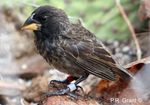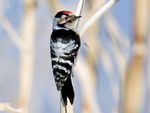Bulletin No 17 RSPB Bath & District Local Group
←
→
Page content transcription
If your browser does not render page correctly, please read the page content below
RSPB Bath & District Local Group
7
Bulletin No 17
Happy New Year to all readers of this Newsletter! May this year be an improvement on 2020,
though with recent freezing weather and a third lockdown, it is getting off to a slow start!
The current lockdown conditions mean that, yet again, we have had to cancel programmed
outdoor visits to Forest of Dean on 16th January and Steart on 2nd February.
Galapagos finch Land iguana ©animalcorner.org
A reminder that our next Zoom ‘indoor’ meeting is on Wednesday 20th January at 7.30pm
with world leading underwater photographer and film maker, Michael Pitts, who will be
telling the story of ‘Galapagos – Islands that Changed the World’. He has worked on a variety
of projects including several for the BBC Natural History Unit, notably on David
Attenborough’s’ Blue Planet and Private Life of Plants. He did the underwater filming for a 3D
series for Sky about the Galapagos which involved David Attenborough, and also other films
about Ascension and the Falkland Islands as part of the BBC Atlantic series. Not to be missed!Big Garden Birdwatch
It’s that time of year again for you to take part in the world’s largest citizen science project
Spend an hour on Friday, Saturday or Sunday 29th, 30th and 31st January and count the birds
you see in your garden, from your balcony or in your local park. Only include those that land,
not those flying over, and count the highest number of birds of one species you see at any
one time, otherwise you count count the same bird more than once! You will be fortunate if
you see one of these!
Waxwings
© The Wildlife Trusts
You can register for Big Garden Birdwatch online via the link below
https://www.rspb.org.uk/get-involved/activities/birdwatch/packrequest/ or drop me an
email (with your postal address) to dirobertson43@gmail.com and I will send you a paper
recording form.
Dancing Birds
Watch this enchanting video!
https://www.youtube.com/watch?v=HzKsfhalAPo
Great spot of a Lesser Spot!
One of our members, Glen Maddison,
saw a Lesser Spotted Woodpecker near
Reception at Prior Park Landscape
Garden last Saturday! What a great start
to his birding year!Birding the Capertee Valley, New South Wales, Australia – Clive Stephens
Episode 1 - Getting there
A black projectile narrowly misses my head, though close enough for me to feel the draught
and then boomerangs back for a repeat performance. Several, well-intentioned, self-
appointed gurus have warned us of the hazards of the Blue Mountains of NSW, (though not
including aerial attack). One warns of its unforgiving remoteness - folk have taken the wrong
track never to be seen again. Another, in contradictory vein, predicts being trampled under a
tidal wave of high summer tourists. Even the instructions from our intending hosts at the
remote Glen Alice Farm warn of kamikaze kangaroos and innumerable MacDonalds though
the latter are not portrayed as hazards at all, but merely useful navigation points. Even our
puny map shows a forbidding route of intestinal tortuousness, like the platters of chitterlings
which used to adorn butchers’ shop windows.
Sulphur crested cockatoo © Clive Stephens
Australian White Ibis or Sacred Ibis, or as the locals rather disparagingly call them "Dump Birds". Pic taken in a fountain in the
Kensington District of Sydney. © Clive StephensWe have left the bruising heat of the Sydney Olympic Park where we have the feeling of having arrived very late at a great theatrical performance, but we resist the temptation to re- run the 5000m. and instead make our first acquaintance with the delicate and busy Superb Fairy Wrens their tails held high like flagpoles, their impossibly blue and black plumage glossy in the beating sun, and on the lagoon a large flock of Red-necked Avocets gracefully wiping their long bills though the silt while the lugubrious Pelicans watch over them and the elegant White Headed Stilts. We make our way to the acclaimed Sydney Visitor Centre where the fearless Rainbow Lorikeets are impressively adept at tearing apart the sugar sachets served with our coffee. The friendly attendants are less intrusive and evidently less knowledgeable. “Capertee Valley - never heard of it. All the maps are in the rack” but which map? After a fruitless search we buy a consolatory sunhat instead and steel ourselves to the challenge of following the “chitterling” route. One real hazard, neglected by our gurus, is the weather and as we hurry past the bloated cuckoo-chick of a cruise-liner, duping the small harbour into giving it solace and then through the claustrophobic road tunnels of N.Sydney, we emerge into a tropical downpour. With an impressive bow wave and limited visibility and with 100 miles to go, we are comforted by the familiarity of road signs as we pass Windsor, Richmond and a sign to Lithgow. Seeking temporary shelter in a small village, we enjoy drinks at a diminutive cafe where a small jazz combo makes an excellent job of recreating the Latin-American jazz of the acclaimed Antonio Carlos Jobim, while outside the splintered shrieks of flocks of pink and grey Galahs curse the punishing weather. We see nothing of the landscape through the persistent louring cloud of the Blue Mountains but tick off several MacDonalds waymarks as for the next two hours we wrestle with the chitterling road. At least it being Sunday, mountainous and wet, we are spared much of the “will-my-truck-fit-in-your-exhaust-pipe” brashness of the customary Australian driving style. No kamikaze kangaroos, either but a gradually deteriorating road surface finally becoming unsealed and potholed as we turn off at Capertee, the last shop we have been warned and still 30 miles from Glen Alice Farm. A note on the Capertee Valley: Situated in the Blue Mountains about 100 miles North-West of Sydney the Valley is said to be the second largest canyon - in terms of width - in the world. It became a mining centre in the mid nineteenth century for the extraction of coal, limestone and shale-oil, though apart from a few derelict buildings little evidence remains. It is classified by Birdlife International as an Important Bird Area and is included in a book by Chris Santella “Fifty Places to Go Birding Before you Die”. 2,000 year-old rock art of the Aboriginal Wiradjuri people has also been found there.
Capertree Valley at dawn © Clive Stephens Blue Mountains National Park © Clive Stephens Blue Mountains Botanic Gardens © Clive Stephens Digiscoping for Birders – Tim Locke I have recently started digiscoping — taking photos and videos using a mobile phone attached to a spotting scope. I was becoming frustrated by the limitations of my telephoto camera lens which, albeit pretty good, cannot defy the laws of physics. Photos of distant birds, even large ones, could disappoint. Having the scope meant I didn’t want to lug around better but inevitably bigger camera gear as well. So that led me to try digiscoping. Instead of using a phone, you can attach a camera body to a scope. But that is more involved and could mean missing a good sighting while removing the camera. Using the phone seemed the way to go in terms of convenience and weight, especially with the rapid improvement in phone camera quality. Key is the adapter you use to fit phone to scope. I have been using one made by Phone Skope in the US. It comprises two bits of plastic to fit your scope and phone and holds my phone firmly and closely to the eyepiece, which is essential. You can, though, remove the phone in an instant to resume viewing.
I found that digiscoping is a technique that takes getting used to and my early photos and
videos were mixed. More recently I have got better shots and clips though current
constraints mean I have not practised as much as I would like. An example is this photo of a
juvenile buzzard which was about 150 metres away — I show the original photo and final
version below. Though it won’t match a photo taken with top range camera equipment I was
pleased with the result especially given the extent of the cropping required.
Original Cropped
There is plenty of information on the web with advice on some optics manufacturers’ and
retailers’ sites, as well as tips on improving your results. Apart from getting a good adapter,
my key tips are: to not use the phone screen to zoom in as picture resolution deteriorates;
and to not optically zoom the scope too much as vibration may impact on picture sharpness.
Editor’s Note
In the 27 December edition of BBC Countryfile, there was a piece with Ellie Harrison and
Simon King showing how to use a similar technique that Tim has described above, but using a
mobile phone/binocular combination. Not as good as using a telescope, but showed what
was possible. Tim has kindly agreed to answer any questions you may have about
digiscoping. Please use the contact form on our Bath Local Group website and questions will
be passed to him for answers. https://ww2.rspb.org.uk/groups/bath/contact/
BBC Winterwatch 2021
Don’t miss Winterwatch 2021 which starts on Tuesday 19 January on BBC 2 at 20.00Dave Newman’s Bird Name Quiz. – Answers
1. 2. 3. 4.
Alan Knott (KNOT) Christopher REEVE JAY Blades Chris Rea (RHEA)
5. 6. 7. 8.
Dean MARTIN George WOODCOCK Florence NIGHTINGALE Donald Swann (SWAN)
9. 10. 11. 12.
Johnny PEACOCK Claire GOOSE John PARROT Richie McCaw (MACAW)
13. 14. 15. 16.
Peter FINCH ROBIN Cousins Sir Christopher WREN Sheryl CROW17. 18. 19. 20. Sigourney WEAVER Walter Pidgeon (PIGEON) Wesley SNIPEs Anthony Quayle (QUAIL) A Poem from Marek Borkowski Many of you will remember what an entertaining evening we had when Marek came to talk to us in 2017 about his conservation work in NE Poland. Well, he has sent us a poem, very relevant for these times. Imagine autumn evening © Marek Borkowski The overwhelming cry Ten thousandth streams of Cranes Crossing fiery sky Imagine there's no virus It isn't hard to do Nothing to kill or die for And no distancing too Imagine all the people Birding with no stress You may say I'm a dreamer But I'm not the only one I hope someday you'll join us And the birding will be done
You can also read



























































